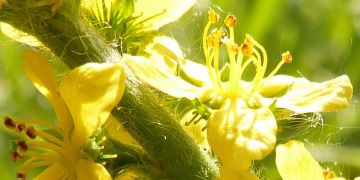Chinese medicine often used Agrimony to treat menstrual difficulties and during the middle ages this herb was used frequently as a sleep aid. In North America agrimony was used for a variety of ailments by Native Americans and up until the late 19th century agrimony was used throughout Europe and North America to treat skin conditions, cough, sore throat, and diarrhea.
Growing Conditions
Agrimony is a fairly common herb that is a member of the Rosaceae or rose family. There are more than twelve different species of this perennial herb throughout Europe, Asia and North America. Agrimonia eupatoria or Common Agrimony is the most prevalent species in Europe while Agrimonia gryposepala, or hairy Agrimony is the most prevalent in North America. This hardy herb can be found growing in woodlands and fields, but also takes well to garden cultivation. In the garden it prefers partial sun and requires regular watering.
Common Agrimony reaches a height of 1 -2 feet with a woody stem covered in a silky down. In some species this down is quite thick giving these the designation of Hairy Agrimony. The leaves are dark green and at the bottom of the plant can be rather large; often seven or more inches long. The leaves reduce in size from the bottom of the plant to the top with those nearest the top being on average about three inches. The small bright yellow flowers are arranged tightly on individual spikes. Both the leaves and the flowers are scented and depending on species the aroma varies from that of apricots to lemons. Once the flowers fade they leave behind prickly burrs that cling to clothes or fur. These are the origin of one of the most common colloquial names for agrimony; the cocklebur.
Active Ingredients
Agrimony contains beneficial active compounds including catechin - a water soluble polyphenol and antioxidant and thiamin - a water soluble B vitamin. It also contains quercitrin an antioxidant and anti-inflammatory that is also the source of its yellow pigmentation. Agrimony contains the complex polyphenol tannin. This bitter plant compound is a natural astringent. Also present in agrimony are palmitic, silicic, and ursolic acids. Palmitic acid is one of the most common saturated fatty acids in both animals and plants. New studies have found that palmetic acid may help fight skin cancer. Silicic acid is a compound of hydrogen, oxygen, and silicon that has been shown to be beneficial to hair, skin, and nails. Ursolic acid is a pentacyclic triterpenoid found in many herbs and fruits that acts as a diuretic and anti-inflammatory. In addition to its medicinal properties, the plant is also used as a dye. The entire plant is used to make dye and when gathered from spring through September, it yields a pale yellow hue. When gathered late in the year, the dye results in a deep rich yellow.
Folklore
The herb has been used extensively in folklore. Witches often used agrimony in spells and to ward off hexes. When placed in a sachet and hung in the home, it was said to provide protection against goblins, evil spirits, and poisoning. Practitioners of voodoo use agrimony to repel jinxes and block curses. It is believed the herb not only repels jinxes and curses, it sends them back against their perpetrator. Today modern day wiccans often place leaves of the plant in pillowcases to ensure a good night's sleep.
How To Use
One of the most common methods of enjoying this useful herb is by making tea. To treat diarrhea a cup of weak tea should be sipped up to six times a day. A stronger tea is used as a gargle to soothe sore throats and quiet coughs. To make the tea add one to two teaspoons of dried leaves stems or flowers to one liter of hot water and steep five to fifteen minutes depending on desired strength. For skin inflammation and to treat wounds soak a compress in very strong tea and apply several times daily. For skin issues essential oil may also be used. Agrimony is available as dried leaves, stems, and flowers, ground power, fluid extract, and essential oil.





